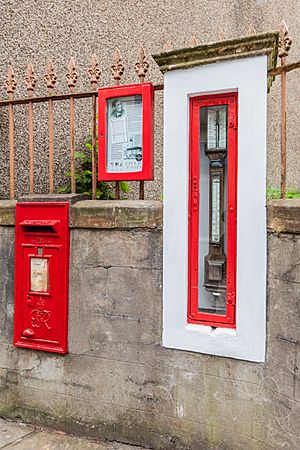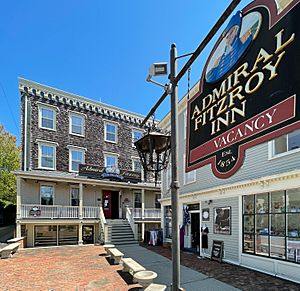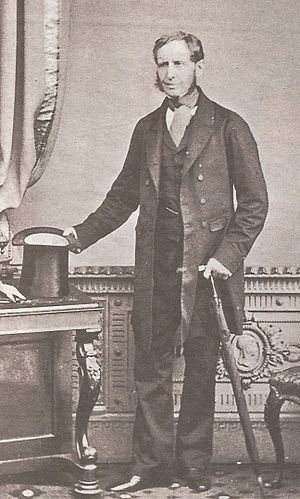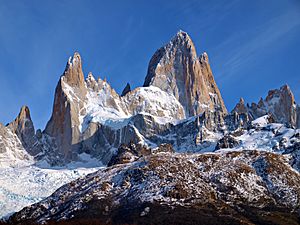Robert FitzRoy facts for kids
Quick facts for kids
Robert FitzRoy
|
|
|---|---|

Robert FitzRoy
|
|
| 2nd Governor of New Zealand | |
| In office 26 December 1843 – 18 November 1845 |
|
| Monarch | Victoria |
| Preceded by | William Hobson |
| Succeeded by | Sir George Grey |
| Personal details | |
| Born | 5 July 1805 Ampton Hall, Ampton, Suffolk, England |
| Died | 30 April 1865 (aged 59) Lyndhurst, Westow Hill, Norwood, England |
| Spouses |
|
| Children | 5 |
Meet Robert FitzRoy, a brave English naval officer and scientist. He is famous for being the captain of HMS Beagle. This was the ship that carried Charles Darwin on his amazing journey around the world. FitzRoy's trip was his second expedition to Tierra del Fuego and the Southern Cone of South America.
FitzRoy was also a pioneer in studying the weather. He made the first daily weather predictions, which he called "forecasts." In 1854, he started what is now known as the Met Office. This office helped sailors and fishermen get important weather information to stay safe. He was also a skilled mapmaker and surveyor. Later, he served as the Governor of New Zealand from 1843 to 1845. There, he worked to protect the Māori people from unfair land deals.
Contents
Robert FitzRoy was born in Ampton, England, in 1805. His family was very important and had a long history of public service. His great-great-great-great-grandfather was Charles II of England, a former king.
In 1818, when he was 12, Robert joined the Royal Naval College in Portsmouth. The next year, he officially joined the Royal Navy. By age 14, he was a student on the ship HMS Owen Glendower. He sailed to South America and returned in 1822.
Robert quickly showed he was a brilliant student. He became a lieutenant in 1824, getting a perfect score on his exam. In 1828, he was assigned to HMS Ganges in South America.
Becoming Captain of the Beagle
At that time, another ship, the Beagle, was mapping the coast of Tierra del Fuego. Its captain, Pringle Stokes, sadly died. So, on December 15, 1828, FitzRoy was made the temporary captain of the Beagle. By the time the ship returned to England in 1830, FitzRoy was known as an excellent surveyor and commander.
During his survey, some local people took a boat from his crew. FitzRoy chased them and took some of their family members as hostages. He ended up with two boys, a girl, and one man. He decided to bring them to England to teach them English and Christian ways. He hoped they would return to their home as missionaries.
The sailors gave them names: the girl was Fuegia Basket, one boy was Jemmy Button, and the man was York Minster. Another boy, Boat Memory, sadly died in England. The others learned a lot and even met King William IV and Queen Adelaide.
HMS Beagle's Second Voyage
In 1831, FitzRoy was preparing for another voyage. He wanted to return the Fuegian people to their home. His friend, Francis Beaufort, helped him get command of the Beagle again. FitzRoy spent a lot of his own money to prepare the ship.
He also wanted a companion for the long journey. He felt that being a captain could be very lonely. He asked for someone who loved science and could study nature during the trip. This led him to choose Charles Darwin as his companion. Before they left, FitzRoy gave Darwin a book called Principles of Geology. This book talked about how Earth's features changed slowly over a very long time.
Life on Board the Beagle
FitzRoy and Darwin generally got along well. However, FitzRoy had a quick temper, which sometimes caused arguments. Once, in Brazil, Darwin was upset about how slaves were treated. FitzRoy disagreed with Darwin's views on slavery. This led to a big argument, and FitzRoy even told Darwin he couldn't eat with him anymore. But FitzRoy quickly apologized, and they continued their journey. They avoided talking about slavery after that.
When they returned to Tierra del Fuego, they tried to set up a mission for the Fuegian people. But when they came back later, their supplies were gone. Only Jemmy Button was found, and he had returned to his old ways. He chose to stay with his people rather than return to England.
While in the Falkland Islands, FitzRoy bought another ship, the Adventure, with his own money. He hoped the Navy would pay him back. But the Navy was unhappy about this. FitzRoy felt criticized and even thought about quitting. His officers convinced him to keep going. He continued the voyage, visiting places like the Galapagos, Tahiti, New Zealand, and Australia.
Return Home and New Work
The Beagle returned to England in October 1836. Soon after, FitzRoy married Mary Henrietta O'Brien. Darwin was surprised because FitzRoy had never mentioned being engaged during their five-year trip!
In 1837, FitzRoy received an award from the Royal Geographical Society. He wrote a detailed account of the voyage, which was published in 1839. It included Darwin's notes as well. In his book, FitzRoy also wrote about his strong belief in the Bible's story of Noah's Flood. He felt that some new scientific ideas went against the Bible.
In 1841, FitzRoy became a Member of Parliament for Durham. He also worked to protect the River Mersey.
Governor of New Zealand
In 1843, FitzRoy was appointed the new Governor of New Zealand. The previous governor had died. FitzRoy's job was to keep peace and protect the Māori people. He also had to deal with many British settlers who wanted to buy land. He had very few soldiers and not much money to do his job.
Challenges in New Zealand
One of his first tasks was to investigate a conflict called the Wairau Affray. Settlers and Māori had fought violently. FitzRoy found that the settlers had acted illegally. He decided not to punish the Māori leader, Te Rauparaha, because he didn't have enough troops to fight him. This made the settlers very angry.
Land sales were a big problem. Settlers wanted land, and some Māori wanted to sell. But the Treaty of Waitangi said the government had to be involved in all land sales. This made things very slow. FitzRoy tried to change the rules to allow direct sales, but it didn't solve the problem.
The colony also faced money problems. FitzRoy tried to raise taxes, but it wasn't enough. He even had to print paper money without enough gold to back it up.
Meanwhile, some Māori leaders in the north, like Hone Heke, felt ignored. To show their anger, Hone Heke cut down the flagpole at Kororareka four times. This led to the First New Zealand War, also called the Flagstaff War. FitzRoy realized he couldn't end the war quickly. Settlers in the United Kingdom complained about his leadership. Because of this, he was replaced by George Grey in 1845. Grey was given more support and money than FitzRoy had received.
Later Life and Weather Forecasting
FitzRoy returned to Britain in 1848. He worked at the Royal Naval Dockyards. In 1850, he retired from active service due to poor health. In 1851, he was elected to the Royal Society, a famous group of scientists, with support from Charles Darwin.
In 1854, FitzRoy was chosen to lead a new department. Its job was to collect weather data from ships at sea. This was the start of the modern Meteorological Office. He gave special instruments to ship captains to help them record weather information.

FitzRoy wanted to share weather information widely to keep sailors and fishermen safe. He designed a special type of barometer that was placed in every port. Sailors could check it before going to sea. These barometers were very popular and had FitzRoy's advice on how to read them.
A terrible storm in 1859, which sank the ship Royal Charter, made FitzRoy work even harder. He created charts to predict the weather and invented the word "weather forecast." In 1861, the first daily weather forecasts were printed in The Times newspaper. He also started a system of warning cones at ports when a storm was coming.
His book, The Weather Book, published in 1863, was very advanced for its time. Even Queen Victoria asked FitzRoy for weather forecasts for her trips!
Many fishing boat owners didn't like the storm warnings because their fleets couldn't leave port. After FitzRoy's death, his warning system was stopped for a short time. But fishermen, who saw FitzRoy as a hero who saved lives, demanded it back. The system was restarted in 1874.
When Darwin's book The Origin of Species was published, FitzRoy was very upset. He felt guilty for his part in its development. At a science meeting in 1860, FitzRoy held up a large Bible. He asked the audience to believe God rather than man. He said Darwin's book had caused him "acutest pain."
Death and Lasting Impact

FitzRoy was promoted to vice-admiral in 1863. In his later years, he faced challenges at the Meteorological Office and had money worries. He also struggled with sadness. On April 30, 1865, Vice-Admiral FitzRoy died. He had spent almost all his money helping the public.
To help his wife and daughter, his friends raised money for them. Charles Darwin even gave £100. Queen Victoria allowed FitzRoy's widow and daughter to live in special apartments at Hampton Court Palace.
Robert FitzRoy is buried in Upper Norwood, London. His memorial was restored in 1981.
FitzRoy's work from the Beagle expeditions helped Chile explore and settle Patagonia. His ideas about a British base in the Straits of Magellan influenced Chile to take control of the straits in the 1840s. Many places are named after him, including Mount Fitz Roy in Argentina and Chile, the Fitzroy River in Australia, and the Fitzroya cupressoides tree. Even a type of dolphin, Delphinus fitzroyi, is named after him.
In 2002, a sea area for weather forecasts was renamed "FitzRoy" in his honor. The Fitzroy Building at the University of Plymouth is also named after him.
Personal Life
Robert FitzRoy was married twice. In 1836, he married Mary Henrietta O'Brien. They had four children: Emily-Unah, Fanny, Katherine, and Robert O'Brien. After Mary's death, he married Maria Isabella Smyth in 1854. They had one daughter, Laura Maria Elizabeth.
Memorials

Many places around the world remember Robert FitzRoy:
- A neighborhood in Punta Arenas, Chile, was named after him in 1964.
- A memorial stands on Isla Navarino in Chile, marking his landing there in 1833.
- Another memorial at Cape Horn remembers his landing in 1830.
- Mount Fitz Roy on the Argentina-Chile border is named after him. It is 3,440 meters (11,286 feet) high.
- The Fitzroy River in Western Australia was named by a later captain of the Beagle.
- The South American tree Fitzroya cupressoides is named after him.
- A type of dolphin, Delphinus fitzroyi, discovered by Darwin, is named in his honor.
- Fitzroy, Falkland Islands and Port Fitzroy, New Zealand, also carry his name.
- A World War II ship, HMS Fitzroy (K553), and a weather ship, Admiral Fitzroy, were named after him.
- New Zealand's NIWA named its supercomputer "FitzRoy" in 2010.
- The "FitzRoy" sea area in the Shipping Forecast is named after him.
- A building at the University of Plymouth is called the Fitzroy Building.
- A blue plaque marks his house in London.
- The Royal Mail issued stamps for the Falkland Islands and St Helena featuring him.
- Fitzroy Island and Fitzroy Crossing in Australia are named after him.
In Fiction
Robert FitzRoy's life has inspired many stories:
- The BBC made a TV series in 1978 called The Voyage of Charles Darwin. Actor Andrew Burt played Captain Robert FitzRoy.
- A play called FitzRoy (also known as The Ostrich and the Dolphin) was first performed in 1997.
- A novel by Sylvia Iparraguirre, Tierra del Fuego (2000), tells the story of FitzRoy's experiment with the Yamaná people.
- The novel This Thing of Darkness by Harry Thompson (2005) follows the lives of FitzRoy and Darwin.
- Sean Hoade's novel Darwin's Dreams (2008) begins with Darwin and FitzRoy meeting.
- A play by Henning Mankell, Darwins Kapten (2009), is about Darwin and his journey on the Beagle.
Images for kids
-
Fitzroy fisheries barometer No 98, Stromness, Orkney
-
Robert FitzRoy's grave outside All Saints' Church, Upper Norwood
-
The Admiral Fitzroy Inn in Newport, Rhode Island, US, is named in his honour
See also
 In Spanish: Robert FitzRoy para niños
In Spanish: Robert FitzRoy para niños
- European and American voyages of scientific exploration
- Second voyage of HMS Beagle
- HMS Beagle
- The Voyage of the Beagle









